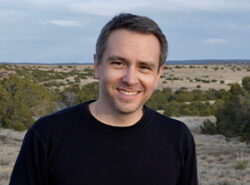Archived Video
Fall 2022 Sciame Lecture Series: C.J. Alvarez
Archived Video
The Natural and Built Environments of the U.S.-Mexico Border
Thursday, Oct 6, 2022
6:00 pm - 7:30 pm
Sciame Auditorium (Room 107)
141 Convent Avenue
New York, NY 10031
Zoom option available

This lecture is held in-person and is part of the Fall 2022 Sciame Lecture Series, titled "Border Crossings: Architecture and Migration in the Americas."
C.J. Alvarez is the author of Border Land, Border Water: A History of Construction on the U.S.-Mexico Divide, the first broad-sweeping history of building projects on the border. He is currently writing a book about the history of the Chihuahuan Desert, the largest and least-known desert in North America. He grew up in Las Cruces, New Mexico, studied art history at Stanford and Harvard, and received his doctorate in history from the University of Chicago. He is currently an associate professor in the department of Mexican American and Latina/o Studies at the University of Texas at Austin.
"The Natural and Built Environments of the U.S.-Mexico Border": The political divide that separates the United States from Mexico passes through six different ecological regions. Each one of these “ecoregions” has a distinctive climate, specific configurations of plants and animals, and unique topography. The political border does not conform in any meaningful way to these environmental boundaries. The political divide does, however, commandeer two rivers -- the Colorado and the Rio Grande -- and for part of their lengths demands that they adhere to the predictability and fixity required of modern political borders. In his book Border Land, Border Water: A History of Construction on the U.S.-Mexico Divide, Alvarez explains the border as a history of accretion, an ever-more complicated system of barrier infrastructure on land and hydraulic engineering projects on the rivers. Today, the environmental unity of border regions has been eclipsed by the built environment which has, in turn, impoverished our imaginations. But his current research and book project go beyond the built environment, deeper into time and further into the realms of the nonhuman world. This talk is about the relationship of political borders and environmental boundaries, the contrast between contemporary political developments and the multimillennial history of environmental regions and rivers, and the tension between anthropocentrism and ecocentrism.
Chair Sean Weiss will introduce the speaker.
Suggested reading: Alvarez's book Border Land, Border Water: A History of Construction on the U.S.-Mexico Divide (University of Texas Press, 2019), or, alternatively, for an article-length piece with some of the key ideas of the book, "Police, Waterworks, and the Construction of the U.S.-Mexico Border, 1924–1954," Western Historical Quarterly, Volume 50, Issue 3, Autumn 2019, Pages 233–256.
"Border Crossings: Architecture and Migration" in the Americas presents meditations on the topic of migration from nontraditional, creative, and interdisciplinary perspectives. The distinguished speakers -- architects, landscape architects, architecture historians, social historians, a philosopher, an anthropologist, and an attorney -- question conventions, especially the conceptualization of migration as linear. They frame migration as a multivalent process, considering the lived realities and material conditions of migration, historically and in the present. Migration in the Americas is more than just the movement and resettlement of bodies, numbers that cross lines and appear/disappear in different places. Migration is not merely (dis)placement, it is also a metamorphosis. Migrants are human beings who are transformed to the core by their movement, and they transform not only their places of departure and arrival, but the entire space that is filled with their journeys.
All lectures are free, open to the public, and held in the Bernard and Anne Spitzer School of Architecture Sciame Auditorium with remote option available. See https://www.ccny.cuny.edu/return-campus for current requirements for in-person visitors.
For remote viewing via Zoom, please register here.
This lecture series is made possible by the Spitzer Architecture Fund and the generous support of Frank Sciame ’74, CEO of Sciame Construction.
Export as:

